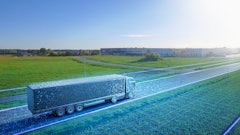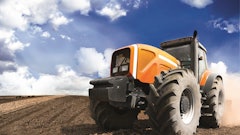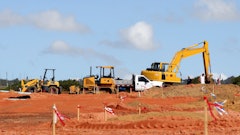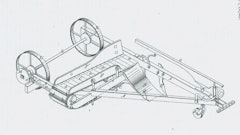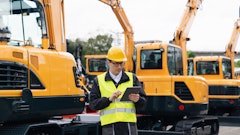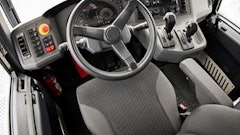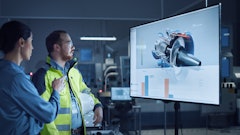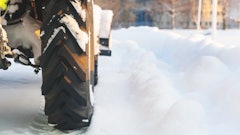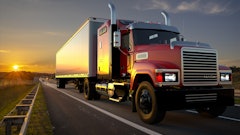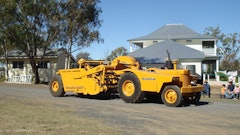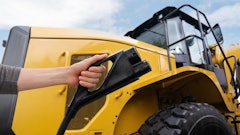
Director, Global Marketing and Sales John Deere Power Systems'
To assess emerging trends and the current and future OEM landscape, our team spoke with experts throughout the industry. In our conversation below, John Deere Power Systems' Director, Global Marketing and Sales Nick Block shares his predictions for the 2024 landscape.
Prior to his current role, Block spent more than 20 years in marketing, sales and customer support in the John Deere Ag & Turf division and Intelligent Solutions Group (ISG). He also served as a regional director for ISG in Latin America. Under Block’s leadership, precision technology adoption and engagement grew rapidly in the region, bringing value to customers, dealers and the John Deere business.
Read on for Block's insights into the state of the industry.
1. What challenges most affected the mobile OEM landscape in 2023?
Supply chain issues continued to be a challenge for original equipment manufacturers (OEMs) in 2023. We’ve seen some improvements to supply chain delays, inventory being rebuilt, and customer demand leveling out. But, many OEMs are still adjusting to this new normal and trying to forecast what future growth looks like in this post-pandemic supply and demand environment. Sustainability continues to be a key topic for OEMs as new technologies come online and they explore what solutions make the most sense for customers and equipment applications. As the off-highway industry — and, really, most industries — continues to work toward a low- and near-zero carbon future, OEMs are working to understand what the total cost of ownership for new technologies like electrification and fuel cells will be and how that will impact customer adoption. We know OEMs are navigating a fragmented and sometimes confusing landscape when it comes to sustainability. Across our portfolio of products, John Deere is committed to investing in and prioritizing solutions that make the most sense for our customers. The past several years have reinforced our stance that the path to a sustainable future will not rely on one single solution. There are applications where internal combustion engines (ICE) will continue to be the optimal solution and others where full battery electric or hybrid diesel-electric will be ideal. For the machine applications where ICE remains the most appropriate power source, biofuels have the potential to make a significant impact on emissions in the near term.
2. What are your predictions for the mobile OEM landscape in 2024?
Next year, we’ll continue to see developments in hybridization within the mobile OEM landscape. We’re watching trends in the on-highway space, and it’s becoming clear hybridization will play an important role as a stepping stone toward full battery adoption. Many off-highway applications are too energy-dense to utilize full battery electric power, but hybridization provides them a way to lower their carbon output by coupling an electrification solution with an engine. We’re continuing to assess this opportunity and explore applications that could benefit from this.We’re also closely watching trends with renewable fuels. There is a lot of potential for offering more sustainable fuel solutions without compromising engine performance. Within the variety of biofuels, John Deere considers biodiesel, renewable diesel (such as HVO), and ethanol to be the most promising options for near-term integration into heavy-duty applications. Knowing the potential for these fuel types, we developed our Next Generation Engine (NGE) technology with features such as dual overhead cams which, in the future, will give us the ability to adapt those engines for spark ignition to burn additional fuels, both liquid and gaseous. We intentionally built that architecture into our NGE lineup in anticipation that our customers will need to source new technologies that address pain points while helping them meet their productivity and sustainability goals. Finally, we’ll continue to see developments in data capture. Changes to emissions regulations — though they will vary by region — are coming, and customers may be required to provide records of their carbon footprint. If that happens, the engine has to be able to track key outputs related to emissions. John Deere has a strong history in our ability to sense and capture data and we’re doing that with our engines just like we are with our tractors. Our John Deere Connected Support technology helps increase efficiency, profitability, and productivity by monitoring equipment health and triggering predictive alerts to dealers so they can proactively manage parts replacement and schedule maintenance to improve customer uptime. Beyond that, we’re also able to track engine performance characteristics that can be leveraged to assess fuel efficiency, as an example.
3. Where do you see the most potential for improvement or advancement in 2024?
The off-highway industry’s diverse needs require a portfolio of solutions to meet power requirements across applications and equipment sizes as we work toward a more sustainable future. With that in mind, I think the areas with the most potential for acceleration are hybridization and the continued development of ICE technology to meet future changes to emissions regulation and the push for sustainability. For heavy-duty applications like those found in the construction industry, we believe there is still a long lifetime ahead for compression ignition engine technology and we are investing in it accordingly with product advancements like the NGE lineup. Battery electric will play a key role for applications such as turf equipment, compact utility tractors, small tractors, compact construction equipment, and some road-building equipment. As I said, we are continuing to assess opportunities for both hybridization and full battery electric. We are developing E-Power machines that utilize battery solutions from Kreisel Electric. E-Drive machines feature an electrified drivetrain with an engine as the primary power source. In addition, E-Drive machines enable better fuel economy, improved powertrain component life, and stronger pushing power on the job than traditional models. By 2026, John Deere aims to offer customers a variety of electric equipment solutions, including 20+ electric and hybrid- models, helping to reduce the carbon footprint of the off-highway industry.
4. What will be the biggest challenge for OEMs and the industry in general in 2024?
When I think about the challenges OEMs and the industry as a whole are facing, I keep coming back to the duality of meeting the current needs of customers while effectively planning for the future and what will be powering their equipment 10, 20, 30 years down the road. OEMs must balance what their customers want and need in a piece of equipment today to get the job done and keep the world running. At the same time, they need to be actively planning for and investing in what their customers will need and require in the future. This is a challenging position to be in, but that is why John Deere is committed to exploring and vetting technologies now that will be viable in the future. We hope our exhaustive efforts to find the best, most realistic solutions will serve our OEMs and their customers well when the time comes for adoption.
5. What factors should engineers and their companies consider when making decisions in the mobile OEM space in 2024?
Previous emissions regulation updates were disruptive for OEMs and their customers from an overall equipment design standpoint and having to navigate new packaging requirements for engines. As we prepare for the next iteration of emissions standards with Tier 5 and Stage VI, engineers and their companies should assess what makes the most sense for their machines and customers. This will help minimize disruption in the adoption of new technologies such as electric drivetrains and renewable fuels. OEMs should also work closely with their distributors as the industry navigates these technological changes. Our distributors are closely monitoring advancements in our engine technologies, with John Deere Connected Support, and the path toward electrification in the future so they can support their OEM customers in those areas. Our distributors are also working to make sure they're able to help customers address what the right time is to change from an old engine model to a new engine model and take advantage of the benefits it provides from not only power density and efficiency but also more sustainable features and a better customer experience.
6. Please highlight ONE recently introduced product from your company that meets a specific, pressing need in the mobile OEM space, and describe briefly how the product is uniquely designed to meet that need.
With our new Next Generation Engine platform, we’ve developed a new engine architecture that delivers new levels of reliability, durability, flexibility, and serviceability along with lower operating costs for a wide array of heavy-duty applications. When developing our latest engine platform, we consulted leading equipment manufacturers to learn more about which engine improvements were at the top of their list. This new engine architecture enables variant extensions that can unlock the potential for broader integration of renewable fuels with combustion engines. Currently, our Next Generation Engine lineup includes the JD4, JD14, and JD18. For the OEM market, I’m really excited about the JD18 and the capabilities it offers for heavy-duty mobile equipment. The JD18 extends our rated power range to 522 – 677 kW (700 – 908 hp). The engine features a rear gear train, which produces excellent direct power and options up to two rear aux drives for a total of 902 Nm (665 lb-ft) max torque providing quiet operation. With peak power ratings from 572 – 677 kW (767 – 908 hp) and new combustion technology, the JD18 does not require aftertreatment. Without the need for DEF, users have one less fluid to manage. The high-pressure common-rail fuel system allows the engine to deliver optimized fluid consumption and the Diamond Like Coating (DLC) improves biodiesel compatibility and system robustness. The new combustion technology features a simplified air system with fixed and wastegate turbos, allowing the engine to meet emissions requirements without applying aftertreatment. This feature provides a simplified engine integration and package size.
7. What are some of your company's priorities in 2024 with regard to electrification, automation, innovation, emission reduction and/or other emerging trends?
I’ve shared several details regarding developments around internal combustion engines, but we also have a lot of exciting developments with electrification as we head into 2024. We are further developing our battery portfolio with Kreisel Electric (“Kreisel”) to include more modular options and broader energy ranges so we can offer OEMs even more versatility for unique application packaging and enable smaller vehicles to take advantage of the high performance of Kreisel batteries. In addition to upfitting a facility to enable battery production at our factory in Saran, France, we’re investing in a new 115,000-square-foot battery manufacturing facility in Kernersville, North Carolina. The facility in North Carolina will be equipped to produce Kreisel battery pack designs and will support a production capacity increase to serve the off-highway market in North America. We broke ground on the new Kernersville facility in fall 2023, and production is estimated to begin in 2025. John Deere also recognizes the important role and opportunity that charging infrastructure presents when it comes to the successful progression and adoption of battery power as an industry. We are working to develop comprehensive charging solutions that our customers can rely on to run in rugged environments. Like batteries, charging requirements will differ by market segment and applications — conceivably needing both stationary and mobile options and versatile ranges and charge times. That’s why we’re building out a diversified battery portfolio and developing a charging ecosystem, starting with the Kreisel CHIMERO battery integrated charging station, to meet operating conditions on a variety of jobsites.
For additional insights on the state of the industry and what's to come in 2024, click here to read more.





